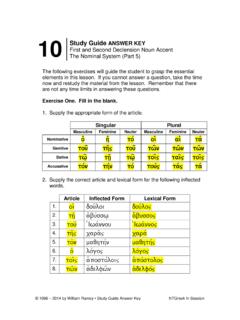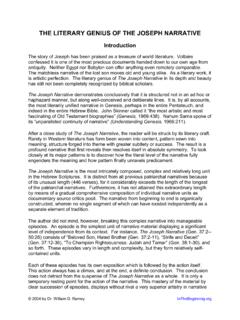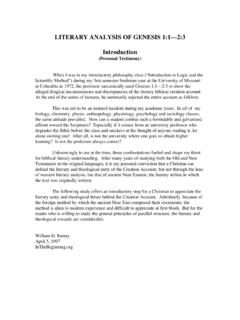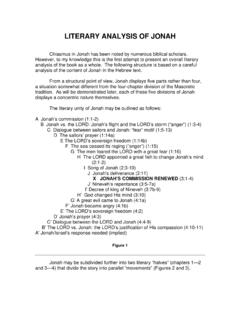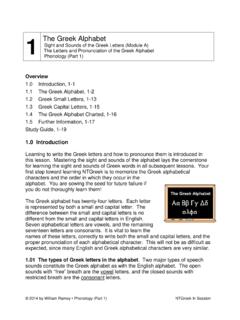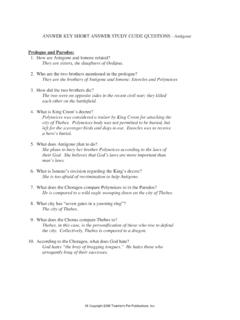Transcription of Lesson 3 | Study Guide Answer Key - …
1 Study Guide Answer KEY Sight and Sounds of Greek Words (Module A) Phonology (Part 3) Exercise One: Short Answer . Briefly Answer the following questions. 1. What constitutes a consonant letter sound? Consonants are made with the breath totally or partly blocked. This hindering of sound is done by the tongue, teeth or lips. Seventeen letters in the Greek alphabet are consonants. 2. Which ten Greek consonants are phonetically equivalent to ten English consonants? Fill in the spaces below with the appropriate Greek or English small letter. Greek letters / English letters b g d k l m n p s t 3.
2 Define what constitutes a vowel letter sound. A vowel letter is an open and freely breathed sound. There are seven vowels in Greek. 4. List the seven Greek vowels, giving both their small and capital forms together. and . 5. Which two Greek vowels are always considered short? and 6. Which two Greek vowels are always considered long? and 7. Which three Greek vowels may be either long or short? , and 3 2014 by William Ramey Study Guide Answer Key NTGreek In Session Lesson 3: Study Guide Answer Key SA3:2 Sight and Sounds of Greek Words (Module A) 8. Fill in the chart below with the appropriate long or short vowel.
3 Be sure to include both the capital and small letters. Always long: Always short: May be long or short: 9. Circle the short vowel corresponding to . 10. Circle the short vowel corresponding to . 11. Which Greek vowels are open and close? What constitutes an open and a close vowel? Open: and . Close: and . An open vowel is pronounced with the mouth open; close vowels with the mouth almost closed. 12. What constitutes a proper Greek diphthong? A proper diphthong is a combination of an open and close Greek vowel. 13. Circle all the Greek proper diphthongs below. 14. What constitutes an improper Greek diphthong? A long vowel with a small iota subscript. 15. What are the three improper Greek diphthongs?
4 2014 by William Ramey Study Guide Answer Key NTGreek In Session Lesson 3: Study Guide Answer Key SA3:3 Sight and Sounds of Greek Words (Module A) 16. What is a dieresis and when is it used? When two vowels that usually form a diphthong, but are pronounced separate, a dieresis is employed. The diaeresis is two dots that always appear above the second vowel. 17. Which two Greek diphthongs are pronounced identical to the long vowel ? The proper diphthong and the improper diphthong 18. Which Greek diphthong is pronounced identical to the long vowel ? The improper diphthong or 19.
5 Which Greek long vowel sound is identical to the improper diphthong ? 20. What constitutes a Greek compound consonant? What are the three Greek compound consonants? Be sure to include their compound phonetic equivalents. Compound consonants are those that are a compound of a consonant and sigma. = = = 21. What constitutes a Greek aspirated consonant? Which four Greek letters are aspirated? What is their common denominator when spelling these letters in English? An aspirated consonant has air accompanying or following when these letters are pronounced: and . Only these Greek letters are spelled with an h in their names. 2014 by William Ramey Study Guide Answer Key NTGreek In Session Lesson 3: Study Guide Answer Key SA3:4 Sight and Sounds of Greek Words (Module A) Exercise Two: True or False Questions.
6 1. Lambda is equivalent in sound to the English l . True 2. Sigma is always equivalent in sound to the English z . False 3. Every Greek letter s phonetic value is derived from the opening sound of its alphabetical name. True 4. The two Greek vowels, eps lon and i ta are always pronounced short. False 5. The two Greek vowels, ta and mega are always pronounced long. True 6. Om kron is the long form for mega. False 7. Alpha is the long form for ta. False 8. The three variable vowels are alpha, i ta, and om kron. False 9. At least six Greek vowels are classified as open . False 10. A proper diphthong is a combination of two open vowels. False 11. is considered a proper diphthong.
7 True 12. is considered a proper diphthong. False 13. The vowel combination, , is a proper diphthong. False 14. The vowel combination, , is a proper diphthong. False 15. There are three improper diphthongs in Greek. True 16. The reduction of a diphthong to a single vowel is called monophthongization. True 17. The i ta subscript may be associated with om kron. False 2014 by William Ramey Study Guide Answer Key NTGreek In Session Lesson 3: Study Guide Answer Key SA3:5 Sight and Sounds of Greek Words (Module A) 18. The i ta adscript is associated with the Greek capitals. True 19.
8 Improper diphthongs may or may not be long in pronunciation. False 20. The i ta subscript does not affect the pronunciation of or . True 21. The i ta subscript and the i ta adscript are useful for distinguishing between the written form, but not pronunciation. True 22. The pronunciations suggested for and are identical. True 23. A compound consonant is one that is a consonant + sigma. True 24. A Greek aspirated consonant is pronounced with air accompanying or following the consonant. True 25. Aspiration is usually signaled by the letter h in English. True 26. The four aspirated Greek consonants are , , , and . True 27. The earliest forms of the Greek letters were the capital letters.
9 True 28. Minuscule letters came before uncial letters. False 29. There are no inscriptions of John s Gospel written with the uncial script. False 30. Majuscule letters came before the uncial letters. True 31. The uncial style extended over one thousand years. True Exercise Three: Multiple Choice. Choose the best Answer . 1. Which letter below is pronounced identically to ? a. c. b. d. 2014 by William Ramey Study Guide Answer Key NTGreek In Session Lesson 3: Study Guide Answer Key SA3:6 Sight and Sounds of Greek Words (Module A) 2. What sounds are the independent and indispensable sounds in speech?
10 A. consonants c. accents marks b. vowels d. breathing marks 3. Examples of Greek epichorical alphabets are: a. Argos and Corinth c. Modern and Ionia b. Koin and Gothic d. boustrophedon 4. Which alphabet is the first known phonetic alphabet? a. Phoenician c. Cyrillic b. Greek d. Hebrew 5. Modern Greek contains how many alphabetical letters? a. twenty-four c. twenty-seven b. twenty-eight d. twenty-one 6. Which one of the following Greek letters sounds like the p in party ? a. c. b. d. 7. Which one of the following Greek letters sounds like the k in kin ? a. c. b. d. 8. Which one of the following letters is an aspirate consonant? a. c. b. d. 2014 by William Ramey Study Guide Answer Key NTGreek In Session Lesson 3: Study Guide Answer Key SA3:7 Sight and Sounds of Greek Words (Module A) 9.
